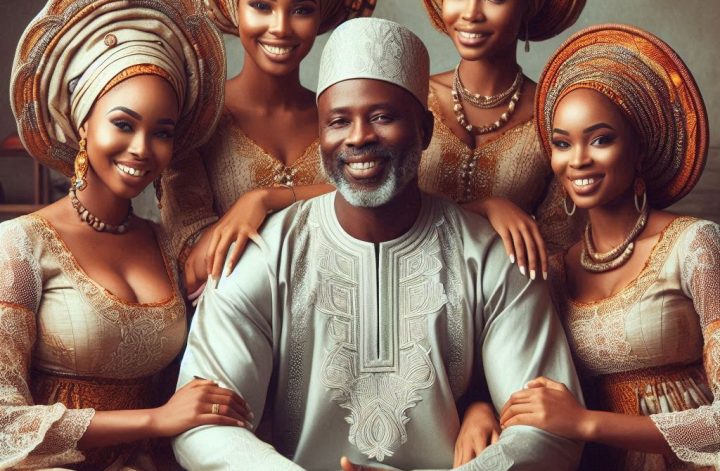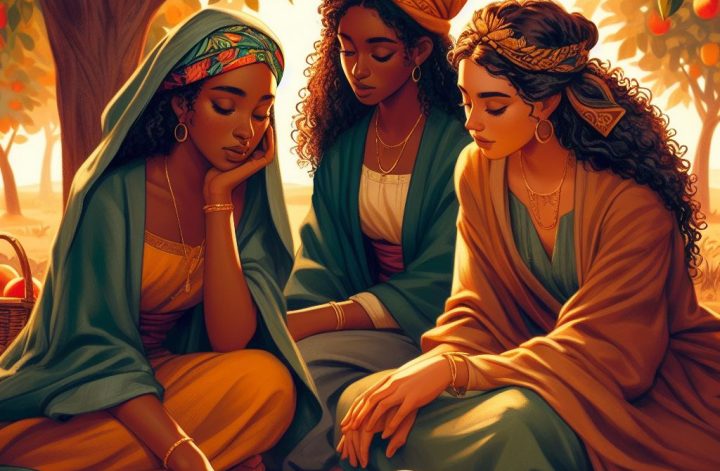African Pentecostals (and their Western Evangelical counterparts) have been taught to look to the pre-Fall portions of Genesis and post-glorification texts of Revelation whenever they want to establish what is ideal. In fairness, the principle works sometimes. For instance, one may legitimately say that the original human diet was plant-based. God says in Genesis 1:29, “I give you every seed-bearing plant on the face of the whole earth and every tree that has fruit with seed in it. They will be yours for food.” Although many Christians dislike this biblical dietary idea, it was really after the Fall that humans ate animals, according to Genesis. Also, it is improbable that glorified humans in the new Eden (Revelations 22) will eat animals for food.
However, the principle does not work with the idea of an ideal marital status. As already argued, not only does Genesis not teach monogamy as the godly form of marriage, there also will be no human marriages post-glorification (Matthew 22:30). Indeed, the only marital language in the New Testament describing Christ’s union with the church is arguably metaphorically polygamous (Ephesians 5:24-27, 2 Corinthians 11:2, Revelations 19:7-9, 21:2), since the church comprises millions of people.
Having argued that Scripture does not privilege monogamy over polygamy, I want to discuss something else recorded in the New Testament. Let us begin with a thought experiment: what would Jesus have said had someone asked, “Rabbi, which is the ideal marital status for your followers – monogamy or polygamy?” I think Jesus would have answered with a trademark better third alternative: neither! Indeed, Matthew includes relevant details in his report of Jesus’s response to the Pharisees’ question on divorce. After the Pharisees had correctly replied that Moses permitted a man to write a certificate of divorce and send the wife away, Jesus countered thus (19:8-9):
Moses permitted you to divorce your wives because your hearts were hard. But it was not this way from the beginning. I tell you that anyone who divorces his wife, except for sexual immorality, and marries another woman commits adultery.
Apparently, the notion of marriage had deteriorated so severely, and the Rabbi Hillel school had become so influential that even Jesus’ disciples thought this teaching was near-impossible to practice. Hence, they commented that “If this is the situation between a husband and wife, it is better not to marry” (19:10). Jesus responded to the disciples’ comment thus (19:11-12):
Not everyone can accept this word, but only those to whom it has been given. For there are eunuchs who were born that way, and there are eunuchs who have been made eunuchs by others—and there are those who choose to live like eunuchs for the sake of the kingdom of heaven. The one who can accept this should accept it.
In this response, Jesus briefly mentions three kinds of eunuchs, well-known people in that region. He talks about some people who simply do not have sexual inclinations or desire to marry (natural eunuchs), those who may desire to marry and be sexually active but cannot because they have been castrated (eunuchs made so by others), and those who heaven empowers to be single. This latter group may occasionally desire the married life but will ultimately decide against it “for the sake of the kingdom of heaven.” Jesus and Paul are examples of people who lived like eunuchs. Here is the critical point. Jesus agrees with the disciples that it is better not to marry (than to be married and later commit adultery) and then adds that “the one who can accept this should accept it.” This is about as clear a teaching on Christian marital status as the entire New Testament contains. For the kingdom’s sake, Jesus teaches that it is better to be single. Phrased differently, Jesus does not teach monogamy as the Christian form of marriage but encourages singlehood instead.
This teaching arguably influenced Paul. After revealing that his unmarried or eunuch life was a gift from God (1 Corinthians 7:7), Paul writes the following:
I would like you to be free from concern. An unmarried man is concerned about the Lord’s affairs—how he can please the Lord. But a married man is concerned about the affairs of this world—how he can please his wife—and his interests are divided. An unmarried woman or virgin is concerned about the Lord’s affairs: Her aim is to be devoted to the Lord in both body and spirit. But a married woman is concerned about the affairs of this world—how she can please her husband. I am saying this for your own good, not to restrict you, but that you may live in a right way in undivided devotion to the Lord. — 1 Corinthians 7:32-35
Here, Paul breaks down Jesus’ “for the sake of the kingdom” phrase into actionable terms that deserve careful parsing. Unmarried Christians have more time and resources to share with God and humans than married people do. Here is an excellent place to denounce the disposition in some churches to view singlehood, especially intentional female singlehood, as a disease; Jesus ranks singlehood for the sake of the kingdom higher than monogamy. Though unmarried, Paul correctly observes that “those who marry will face many troubles in this life” (1 Corinthians 7:28). Every married person knows this to be true.
Hence, we can safely deduce an inference from Paul’s Christ-influenced theology. If we were to ask Apostle Paul to comment on our subject, monogamy or polygamy, I have no doubts that Paul would emphatically prefer monogamy to polygamy. However, he would not decide against polygamy because it is supposedly a sin like those European missionaries to Africa thought and taught. In principle, Paul would prefer monogamy because it allows for more time to do kingdom work than polygamy would. Ideally, however, Paul, like Jesus, would have preferred singlehood. Since we cannot universalize singlehood without undermining humanity, however, some people will continue to get married—by both monogamy and polygamy.
Women and Polygyny
There is no questioning the fact that women often are victims of polygyny. Sometimes, a woman may even cause the victimization of another woman. The case of biblical Sarah and Hagar is a good example. Under a belief that the birthing of a child under her roof would help her condition, barren Sarah offered her Egyptian servant to Abraham to impregnate. The Bible does not record conversations seeking Hagar’s consent or interest. Sarah merely needed Hagar’s womb. Hagar was likely a teenager, and Abraham was about 85 years old. By today’s standards, this would likely be (statutory) rape. Patriarchy asymmetrically empowers men, and men often use polygyny against women.
Besides, ancient civilizations tend to think of women as ontologically inferior to men. For instance, Moses permitted Israelite men to send their wives away for almost any reason:
If a man marries a woman who becomes displeasing to him because he finds something indecent about her, and he writes her a certificate of divorce, gives it to her, and sends her from his house, and if after she leaves his house she becomes the wife of another man, and her second husband dislikes her and writes her a certificate of divorce, gives it to her and sends her from his house, or if he dies, then her first husband, who divorced her, is not allowed to marry her again after she has been defiled. – (Deuteronomy 24:1-4).
While such a law contextually prevented men from pimping women in that society, it also gave much power to men over women. Of course, this was the text that Rabbi Hillel used to argue that men could divorce Jewish women for any and every reason. It also could be that developments of this sort necessitated the redactional element in Genesis 2:24, as discussed earlier.
Similarly, African men also typically multiply wives at will. Many African states consider polygyny a thing of prestige. As Gitari writes, “Whenever the society considers polygamy as a social ideal, culturally and traditionally, the polygamist enjoys superior prestige and as a result, well-to-do males will tend to acquire more than one wife” (7). Hence, there is a genuine sense in which women are used as trophies in some contexts. Likewise, Europeans do not fare any better in their treatment of women. For instance, women could not vote in many European states and the United States until the 20th century. Polygamy also existed in early Europe. In all these cases, we see patriarchy making life difficult for women.
However, we still must be cautious against hasty generalizations. While many Western women today cannot imagine sharing their husbands with another woman, this is not always true for women in other cultures. Precisely because marriage in Africa is typically duty-oriented and unromantic and sex is primarily for procreation, some African women would gladly welcome a new wife into their marital homes, especially at menopause (Baloyi, 169 – 170). A new wife would relieve the first wife of sexual duties—something some wives may not enjoy—while also receiving help with house chores. Of course, a new wife also means fresh troubles, but some first wives deem domestic misunderstandings negligible compared to the benefits a new wife promises. In some ancient African contexts, first wives also wielded considerable power and often had businesses independent of their husbands.
European missionaries wrongly judged African marriage norms and concluded that the women needed saving from polygyny. Their judgment is, however, not necessarily accurate. Catrien Notermans performed an anthropological study of Christian eastern Cameroon women in polygamous marriages. The women all belonged to denominations such as the Catholic and Presbyterian Churches whose official rulings yet forbid polygyny. They were members of denominations wanting to save them from polygyny. However, these women disagreed with their churches’ official rulings. Notermans writes that these “women successfully combine polygyny and Christianity. They cannot be seen as passive recipients of Christianity who have to be saved from polygyny, but as active innovators who creatively integrate Christianity into their married lives” (351). Unlike their white church leadership, these Cameroonian women “do not judge polygyny as a moral problem” (351); instead, they conclude that what could be problematic is “the way polygyny is performed in everyday life” (351). That is, there is a right way to function in polygynous contexts.
Notermans further observes that the Cameroonian women “engage in Christianity on terms that are largely their own: they consider Christianity to be useful in one’s relationship to others and in particular to those who take part in the same polygynous household” (351). That is, African women used Christianity to improve polygyny.
What about Polyandry?
Polyandry is a type of polygamy where a woman is simultaneously married to more than one man. We have no biblical examples, but some Western theologians have used the text of Romans 7:1-3 to argue against polyandry:
Since I am speaking to those who know the law, brothers and sisters, don’t you know that the law rules over someone as long as he lives? For example, a married woman is legally bound to her husband while he lives. But if her husband dies, she is released from the law regarding the husband.So then, if she is married to another man while her husband is living, she will be called an adulteress. But if her husband dies, she is free from that law. Then, if she is married to another man, she is not an adulteress.
When we read closely, however, we observe that Paul is here discussing Jewish law. He writes about how the Jewish law forbids a Jewish woman from having multiple husbands simultaneously. It is an illegitimate stretch to say that this passage forbids non-Jewish polyandry.
Nevertheless, polyandry is a relatively rare marriage form. It exists in South Asia and among the Irigwe people of Plateau, Nigeria. Polyandrous unions are not homogenous. Indeed, each of the studied polyandrous marriages differs from one another. Whereas we often believe polygyny started in an agricultural age among people with a surplus of land and conducive weather, humans seem to have devised polyandry in contexts where land was scarce. Interestingly, one of the unique things that polyandry studies have unearthed is the need to separate a woman’s sexual attribute from her reproductive attribute. These two distinct female attributes are often lumped together in monogamous and polygynous marriages, and a husband holds the right to them for as long as a marriage lasts.
Northern Nigeria’s kind of polyandry, also technically known as secondary marriage, seems to have been hugely influenced by the people’s distaste for divorce. Levine and Sangree observe:
Secondary marriage implies sequential marital rites and serial cohabitations, without the severance of prior unions or the cessation of the rights and duties associated with these prior unions. Thus a woman may cohabit with a first husband, marry a second and leave the first without abrogating her right to return to the first and have children by him at a later date. . . . Although the woman does not live with all her husbands at the same time, she is concurrently wed to all of them and these marriages last for life (400).
This marital practice may be repulsive to a Westernized mind, but the Nigerian people solved a human problem the best way they knew how. Besides, perhaps polyandry is not any worse than the now commonplace Western practice of divorce. Nevertheless, we have no explicit biblical prohibition of polyandry for all—though we also do not have biblical cases of this marriage form.
Practical Applications: Christian Men and Polygamy
I believe strongly that European missionaries to Africa should have merely sown the seeds of Christian ethics into the cultures and allowed things to work out naturally. They should have primarily instructed and encouraged the men in two areas: loving their wives as they love themselves and doing unto their wives as they would want the wives to do unto them, and vice versa. Doing this would imply that over time and as God works on their hearts, men would be slowly discouraged from taking additional wives without the consent of their (first) wives—unless the husbands would genuinely not mind their wives multiplying husbands without their permission. Of course, these things may take a few generations before society-wide fruits manifest, but this seems like a more meaningful Christian missionary goal than the demonization that accompanied European missionary efforts in Africa.
Someone may yet ask, “Can a monogamously married Christian man take on additional wives today?” I think we must be aware of the context. The context may influence our answer. In a primarily polygamous environment, for instance, where centuries of tradition have shaped both men and women, the question may take a distinct form than in a monogamous culture. I am, however, convinced that, in all cases, a monogamously married Christian man ought not to multiply wives without the free consent of the wife. I cannot see how a Christian who truly loves their spouse would do something that hurts the marital partner they claim to love. In other words, if a Christian wife really and freely consents to her husband’s taking of an additional wife, there would be nothing sinful or unchristian about it—and I think the reverse holds as well. If we cringe at a woman multiplying husbands, we should also cringe at the thought of a man multiplying wives. That is my polygamy principle.
The formulation above deserves additional fleshing out. First, as my wife made me aware, the very act of a husband asking a wife about multiplying wives communicates to the wife that she is inadequate. In other words, the asking already promises to hurt the spouse and is potentially inherently unloving. So, it would be vanishingly rare to meet the conditions of the principle above.
Second, I use “free consent” and “freely” philosophically, and explaining what is meant through examples may be better. Baloyi enumerates some ways by which Africans justify polygamy, including its being a solution for infertility (168). The idea is that it is better to marry another wife than kick out the existing wife. This practice continues a patriarchy-inflected, pre-scientific notion that infertility was a woman’s problem. Other justifications Baloyi lists include polygamy as a solution during pregnancy, nursing, and menopause (169 – 170). In some African cultures, people believe it is taboo to continue to engage in sexual activities when pregnant, nursing, or at menopause, and polygyny is seen as a healthier solution. In other words, women in these settings would agree that their husbands should take on a new wife as a conciliatory move to prevent him from sleeping around. For these women, my test-for-polygamy formulation above may apply. But it must be pointed out, as Baloyi advocates (178), that should these women become informed and convinced that medical science can alleviate their concerns, they could no longer freely grant their consent to polygyny, even if polygamy remains culturally acceptable.
Finally, let us consider another case more pertinent to African churches. What happens if an already polygamous man, say a traditional African or Muslim man, embraces Jesus and wants to join a local church? We must not go the way of the European missionaries in Africa who broke up families in Jesus’ name. Instead, we may take solace in the following Pauline insight in 1 Corinthians 7:20, “Each one should remain in the condition in which he was called.”
Works Cited
Baloyi, Elijah M.. (2013). Critical reflections on polygamy in the African Christian context. Missionalia, 41(2), 164-181. Retrieved October 30, 2024, from http://www.scielo.org.za/scielo.php?script=sci_arttext&pid=S0256-95072013000800006&lng=en&tlng=en.
Gitari, David. “The Church and Polygamy.” Transformation, vol. 1, no. 1, 1984, pp. 3–10. JSTOR, www.jstor.org/stable/43052879. Accessed 4 Apr. 2021.
Levine, Nancy E., and Walter H. Sangree. “Conclusion: Asian and African Systems of Polyandry.” Journal of Comparative Family Studies, vol. 11, no. 3, 1980, pp. 385–410. JSTOR, www.jstor.org/stable/41601145. Accessed 4 Apr. 2021.
Notermans, Catrien. “True Christianity without Dialogue: Women and the Polygyny Debate in Cameroon.” Anthropos, vol. 97, no. 2, 2002, pp. 341–353. JSTOR, www.jstor.org/stable/40466036. Accessed 4 Apr. 2021.





2 Comments